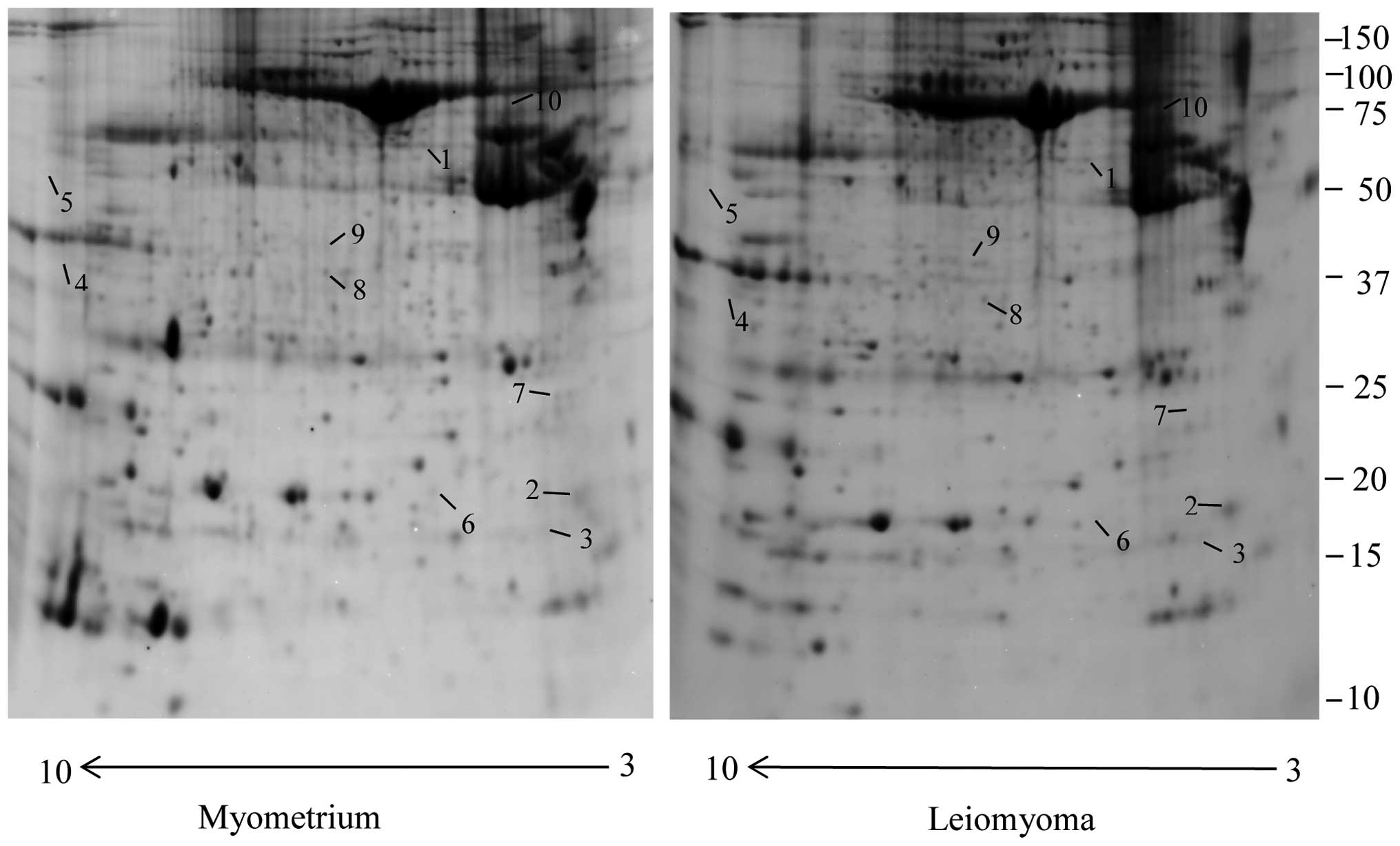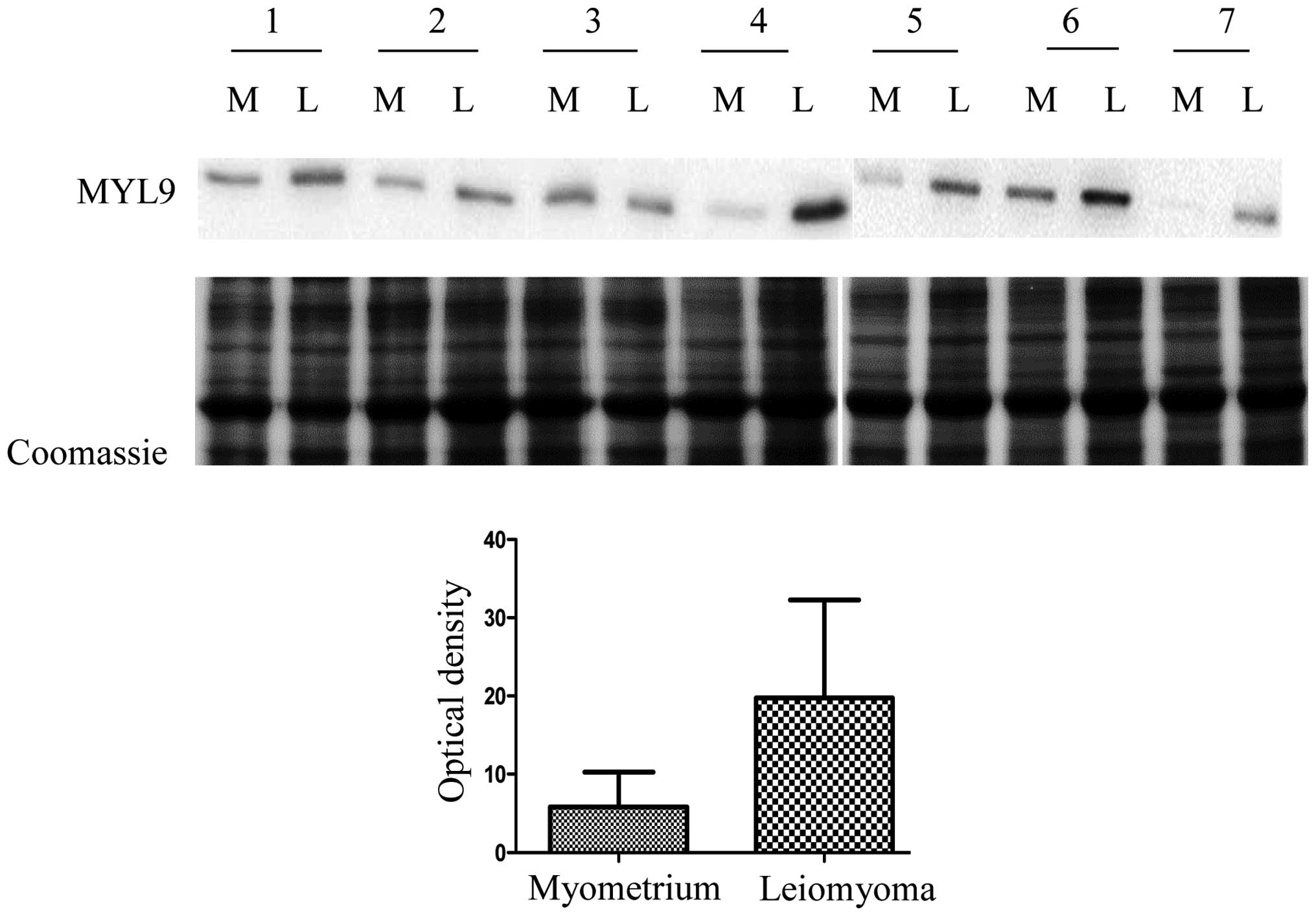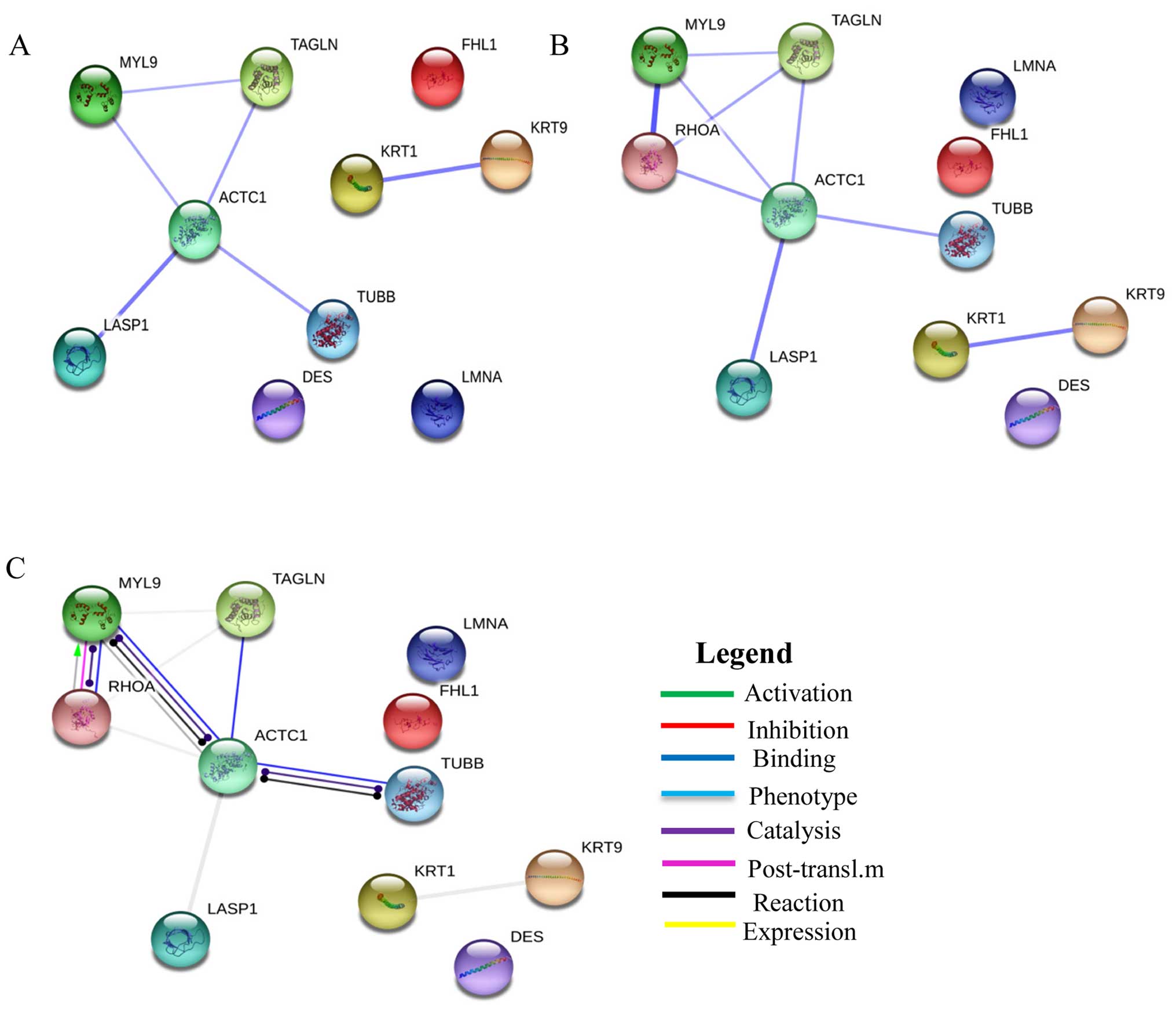|
1
|
Rein MS: Advances in uterine leiomyoma
research: The progesterone hypothesis. Environ Health Perspect.
108(Suppl 5): 791–793. 2000. View Article : Google Scholar : PubMed/NCBI
|
|
2
|
Catherino WH and Malik M: Uterine
leiomyomas express a molecular pattern that lowers retinoic acid
exposure. Fertil Steril. 87:1388–1398. 2007. View Article : Google Scholar : PubMed/NCBI
|
|
3
|
Arslan AA, Gold LI, Mittal K, Suen TC,
Belitskaya-Levy I, Tang MS and Toniolo P: Gene expression studies
provide clues to the pathogenesis of uterine leiomyoma: New
evidence and a systematic review. Hum Reprod. 20:852–863. 2005.
View Article : Google Scholar : PubMed/NCBI
|
|
4
|
Leppert PC, Jayes FL and Segars JH: The
extracellular matrix contributes to mechanotransduction in uterine
fibroids. Obstet Gynecol Int. 2014:7832892014. View Article : Google Scholar : PubMed/NCBI
|
|
5
|
Davis BJ, Risinger JI, Chandramouli GV,
Bushel PR, Baird DD and Peddada SD: Gene expression in uterine
leiomyoma from tumors likely to be growing (from black women over
35) and tumors likely to be non-growing (from white women over 35).
PLoS One. 8:e639092013. View Article : Google Scholar : PubMed/NCBI
|
|
6
|
Wang Y, Feng G, Wang J, Zhou Y, Liu Y, Shi
Y, Zhu Y, Lin W, Xu Y and Li Z: Differential effects of tumor
necrosis factor-α on matrix metalloproteinase-2 expression in human
myometrial and uterine leiomyoma smooth muscle cells. Hum Reprod.
30:61–70. 2015. View Article : Google Scholar
|
|
7
|
Elosegui-Artola A, Bazellières E, Allen
MD, Andreu I, Oria R, Sunyer R, Gomm JJ, Marshall JF, Jones JL,
Trepat X, et al: Rigidity sensing and adaptation through regulation
of integrin types. Nat Mater. 13:631–637. 2014. View Article : Google Scholar : PubMed/NCBI
|
|
8
|
Vincent S and Settleman J: The PRK2 kinase
is a potential effector target of both Rho and Rac GTPases and
regulates actin cytoskeletal organization. Mol Cell Biol.
17:2247–2256. 1997. View Article : Google Scholar : PubMed/NCBI
|
|
9
|
Luo XG, Zhang CL, Zhao WW, Liu ZP, Liu L,
Mu A, Guo S, Wang N, Zhou H and Zhang TC: Histone methyltransferase
SMYD3 promotes MRTF-A-mediated transactivation of MYL9 and
migration of MCF-7 breast cancer cells. Cancer Lett. 344:129–137.
2014. View Article : Google Scholar
|
|
10
|
Ura B, Scrimin F, Zanconati F, Arrigoni G,
Monasta L, Romano A, Banco R, Zweyer M, Milani D and Ricci G:
Two-dimensional gel electrophoresis analysis of the leiomyoma
interstitial fluid reveals altered protein expression with a
possible involvement in pathogenesis. Oncol Rep. 33:2219–2226.
2015.PubMed/NCBI
|
|
11
|
Norian JM, Owen CM, Taboas J, Korecki C,
Tuan R, Malik M, Catherino WH and Segars JH: Characterization of
tissue biomechanics and mechanical signaling in uterine leiomyoma.
Matrix Biol. 31:57–65. 2012. View Article : Google Scholar
|
|
12
|
Mischiati C, Ura B, Roncoroni L, Elli L,
Cervellati C, Squerzanti M, Conte D, Doneda L, Polverino de Laureto
P, de Franceschi G, et al: Changes in protein expression in two
cholangiocarcinoma cell lines undergoing formation of
multi-cellular tumor spheroids in vitro. PLoS One. 10:e01189062015.
View Article : Google Scholar
|
|
13
|
Lv J, Zhu X, Dong K, Lin Y, Hu Y and Zhu
C: Reduced expression of 14-3-3 γ in uterine leiomyoma as
identified by proteomics. Fertil Steril. 90:1892–1898. 2008.
View Article : Google Scholar
|
|
14
|
Mouw JK, Yui Y, Damiano L, Bainer RO,
Lakins JN, Acerbi I, Ou G, Wijekoon AC, Levental KR, Gilbert PM, et
al: Tissue mechanics modulate microRNA-dependent PTEN expression to
regulate malignant progression. Nat Med. 20:360–367. 2014.
View Article : Google Scholar : PubMed/NCBI
|
|
15
|
Butcher DT, Alliston T and Weaver VM: A
tense situation: Forcing tumour progression. Nat Rev Cancer.
9:108–122. 2009. View
Article : Google Scholar : PubMed/NCBI
|
|
16
|
Cooper JA: The role of actin
polymerization in cell motility. Annu Rev Physiol. 53:585–605.
1991. View Article : Google Scholar : PubMed/NCBI
|
|
17
|
Salama SA, Kamel MW, Botting S, Salih SM,
Borahay MA, Hamed AA, Kilic GS, Saeed M, Williams MY and
Diaz-Arrastia CR: Catechol-o-methyltransferase expression and
2-methoxyestradiol affect microtubule dynamics and modify steroid
receptor signaling in leiomyoma cells. PLoS One. 4:e73562009.
View Article : Google Scholar : PubMed/NCBI
|
|
18
|
Ganguly A, Yang H and Cabral F: Class III
β-tubulin counteracts the ability of paclitaxel to inhibit cell
migration. Oncotarget. 2:368–377. 2011. View Article : Google Scholar : PubMed/NCBI
|
|
19
|
Roeder HA, Cramer SF and Leppert PC: A
look at uterine wound healing through a histopathological study of
uterine scars. Reprod Sci. 19:463–473. 2012. View Article : Google Scholar : PubMed/NCBI
|
|
20
|
Brown S, McGrath MJ, Ooms LM, Gurung R,
Maimone MM and Mitchell CA: Characterization of two isoforms of the
skeletal muscle LIM protein 1, SLIM1. Localization of SLIM1 at
focal adhesions and the isoform slimmer in the nucleus of myoblasts
and cytoplasm of myotubes suggests distinct roles in the
cytoskeleton and in nuclear-cytoplasmic communication. J Biol Chem.
274:27083–27091. 1999. View Article : Google Scholar : PubMed/NCBI
|
|
21
|
Robinson PA, Brown S, McGrath MJ, Coghill
ID, Gurung R and Mitchell CA: Skeletal muscle LIM protein 1
regulates integrin-mediated myoblast adhesion, spreading, and
migration. Am J Physiol Cell Physiol. 284:C681–C695. 2003.
View Article : Google Scholar
|
|
22
|
Huveneers S and Danen EH: Adhesion
signaling - crosstalk between integrins, Src and Rho. J Cell Sci.
122:1059–1069. 2009. View Article : Google Scholar : PubMed/NCBI
|
|
23
|
Liao XH, Wang N, Liu LY, Zheng L, Xing WJ,
Zhao DW, Sun XG, Hu P, Dong J and Zhang TC: MRTF-A and STAT3
synergistically promote breast cancer cell migration. Cell Signal.
26:2370–2380. 2014. View Article : Google Scholar : PubMed/NCBI
|
|
24
|
Medjkane S, Perez-Sanchez C, Gaggioli C,
Sahai E and Treisman R: Myocardin-related transcription factors and
SRF are required for cytoskeletal dynamics and experimental
metastasis. Nat Cell Biol. 11:257–268. 2009. View Article : Google Scholar : PubMed/NCBI
|
|
25
|
Roth W, Kumar V, Beer HD, Richter M,
Wohlenberg C, Reuter U, Thiering S, Staratschek-Jox A, Hofmann A,
Kreusch F, et al: Keratin 1 maintains skin integrity and
participates in an inflammatory network in skin through
interleukin-18. J Cell Sci. 125:5269–5279. 2012. View Article : Google Scholar : PubMed/NCBI
|
|
26
|
Dandapani SV, Sugimoto H, Matthews BD,
Kolb RJ, Sinha S, Gerszten RE, Zhou J, Ingber DE, Kalluri R and
Pollak MR: α-actinin-4 is required for normal podocyte adhesion. J
Biol Chem. 282:467–477. 2007. View Article : Google Scholar
|
|
27
|
Grunewald TG and Butt E: The LIM and SH3
domain protein family: Structural proteins or signal transducers or
both? Mol Cancer. 7:312008. View Article : Google Scholar : PubMed/NCBI
|
|
28
|
Matsson H, Eason J, Bookwalter CS, Klar J,
Gustavsson P, Sunnegårdh J, Enell H, Jonzon A, Vikkula M, Gutierrez
I, et al: α-cardiac actin mutations produce atrial septal defects.
Hum Mol Genet. 17:256–265. 2008. View Article : Google Scholar
|
|
29
|
Choi CK, Vicente-Manzanares M, Zareno J,
Whitmore LA, Mogilner A and Horwitz AR: Actin and α-actinin
orchestrate the assembly and maturation of nascent adhesions in a
myosin II motor-independent manner. Nat Cell Biol. 10:1039–1050.
2008. View
Article : Google Scholar
|
|
30
|
Dechat T, Adam SA, Taimen P, Shimi T and
Goldman RD: Nuclear lamins. Cold Spring Harb Perspect Biol.
2:a0005472010. View Article : Google Scholar : PubMed/NCBI
|
|
31
|
Iyer KV, Pulford S, Mogilner A and
Shivashankar GV: Mechanical activation of cells induces chromatin
remodeling preceding MKL nuclear transport. Biophys J.
103:1416–1428. 2012. View Article : Google Scholar : PubMed/NCBI
|
|
32
|
Dvorakova M, Nenutil R and Bouchal P:
Transgelins, cytoskeletal proteins implicated in different aspects
of cancer development. Expert Rev Proteomics. 11:149–165. 2014.
View Article : Google Scholar : PubMed/NCBI
|
|
33
|
Yang Z, Chang YJ, Miyamoto H, Ni J, Niu Y,
Chen Z, Chen YL, Yao JL, di Sant'Agnese PA and Chang C: Transgelin
functions as a suppressor via inhibition of ARA54-enhanced androgen
receptor transactivation and prostate cancer cell growth. Mol
Endocrinol. 21:343–358. 2007. View Article : Google Scholar
|
|
34
|
Li Q, Shi R, Wang Y and Niu X: TAGLN
suppresses proliferation and invasion, and induces apoptosis of
colorectal carcinoma cells. Tumour Biol. 34:505–513. 2013.
View Article : Google Scholar
|













